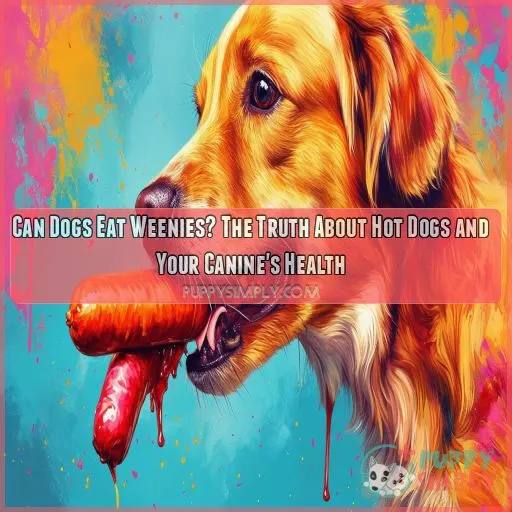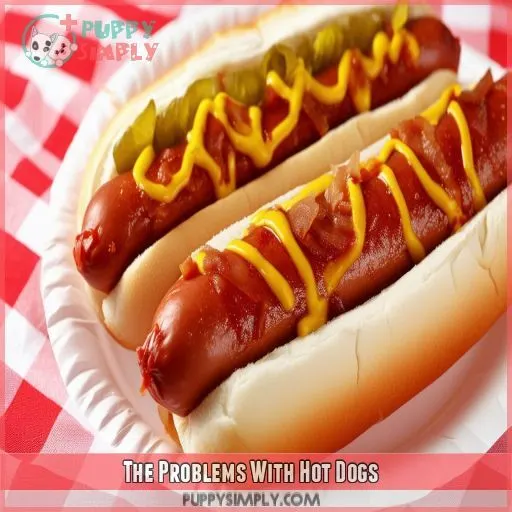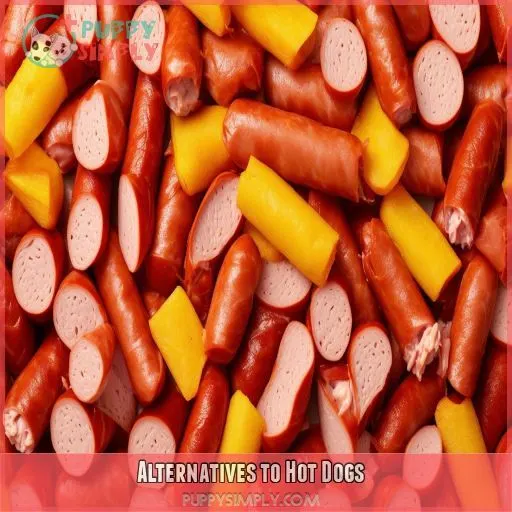This site is supported by our readers. We may earn a commission, at no cost to you, if you purchase through links.
 You ever wondered if your furry friend could have a share of your hot dog indulgence? Though dogs may beg for a bite, the truth about wieners and canine health is much more complicated than one would think.
You ever wondered if your furry friend could have a share of your hot dog indulgence? Though dogs may beg for a bite, the truth about wieners and canine health is much more complicated than one would think.
Hot dogs, odorous and savory as they may seem, really present several dangers to the health of your dog. Ranging from harmful ingredients to high sodium content, these famous treats could very well be what causes serious health concerns for your furry friend.
Let’s discuss why hot dogs are not an excellent choice for dogs and outline much healthier options that’ll keep your pup’s tail wagging without compromising their health
Table Of Contents
- Key Takeaways
- Can Dogs Eat Weenies?
- The Problems With Hot Dogs
- Alternatives to Hot Dogs
- Healthy Alternatives to Hot Dogs
- What the Experts Say About Hot Dogs for Dogs
- Frequently Asked Questions (FAQs)
- What happens if a dog eats hot dogs?
- What hotdogs are safe for dogs?
- What foods are toxic to dogs?
- Can dogs eat hot dog buns?
- Can a dog eat a weenie?
- Can dogs eat raw hot dogs?
- Should I give my Dog a Weeny?
- Are Wieners bad for dogs?
- How Much Hot Dog Can a Dog Safely Eat?
- Are Hot Dogs a Good Source of Nutrition for Dogs?
- How Can I Tell if My Dog is Having an Adverse Reaction to a Hot Dog?
- Is It Necessary to Cook Hot Dogs Before Feeding Them to My Dog?
- Are There Any Breeds of Dogs That Should Not Eat Hot Dogs?
- Are kosher hot dogs safer for dogs?
- Can puppies eat hot dogs as training treats?
- How long can hot dogs sit out for dogs?
- Do vegetarian hot dogs pose the same risks?
- Can hot dog water be harmful to dogs?
- Conclusion
Key Takeaways
- Hot dogs are a no-go for Fido – they’re packed with more salt than a sailor’s vocabulary and could turn your pup’s tummy into a storm at sea.
- Swap those weenies for winner treats! Think crisp apple slices or crunchy carrots – your furry friend’s tail will wag harder than a metronome on caffeine.
- Even a tiny bite of hot dog could spell trouble. It’s like playing culinary Russian roulette with your pooch’s health – why risk it when there are safer options?
- When it comes to treats, listen to the experts (aka your vet), not your dog’s puppy eyes. They might beg like there’s no tomorrow, but your job is to think about their many tomorrows to come
Can Dogs Eat Weenies?
You don’t want to feed your dog weenies or hot dogs because, as inviting as they may seem, processed meats are full of unhealthy ingredients and too much sodium. One has over double the amount of sodium the dog should consume in a day, and causes dehydration, which subsequently leads to obesity.
Further, the toxic additives and high fat content raise the risk of pancreatitis and digestive distress. Add the potential choking hazard in there, especially with the smaller breeds.
Go for healthier choices; plain cooked meats, crisp apple slices, and crunchy carrot sticks alone make for better food with no risks.
Want to know what the experts say regarding this? Read on
The Problems With Hot Dogs
You might think hot dogs are a harmless treat for your dog, but they’re packed with harmful ingredients and excessive sodium. These processed meats can lead to serious health issues for your canine companion, including dehydration, high blood pressure, and even toxicity from certain additives
Harmful Ingredients in Hot Dogs
Hot dogs contain ingredients that can be harmful to your furry friend. Watch out for toxic additives like sodium nitrate, garlic powder, and onion powder. These can lead to serious health issues.
Here’s why hot dogs are a no-go for your pup:
- Increased risk of pancreatitis
- Potential for kidney strain
- Possible choking hazard
High Sodium Content
Hot dogs pack a sodium punch that’s risky for your furry friend. Here’s what you need to know:
- A single hot dog contains 500mg of sodium
- Dogs weighing 33 pounds only need 200mg daily
- Half a hot dog exceeds their daily limit
Excess sodium can lead to dehydration and obesity. Always consult your vet for advice
Consequences of Dogs Eating Hot Dogs
Feeding your dog hot dogs can lead to serious health issues. Here’s what you need to know:
- Digestive distress (bellyache, diarrhea, vomiting)
- Dehydration
- Increased risk of pancreatitis
- Potential for choking
Instead of hot dogs, consider alternatives like plain beef or specific dog treats that meet your pup’s nutritional needs without the risks of overfeeding or harmful ingredients
Alternatives to Hot Dogs
Now that we’ve seen why hot dogs aren’t ideal for your furry friend, let’s explore some safer alternatives. You’ll want to choose options that are both nutritious and appealing to your pup. Here are some alternatives to hot dogs that you can feel good about offering:
- Plain, cooked meats like beef, pork, or chicken
- Homemade dog treats without harmful ingredients
- Small pieces of fresh fruits and vegetables (avoiding toxic ones)
- Commercial dog treats formulated for puppy nutrition
- Low-sodium, dog-safe human foods
When preparing these alternatives, remember to:
- Avoid artificial sweeteners and onion powder
- Cut food into small, bite-sized pieces to prevent choking
- Consider your dog’s individual dietary needs
- Check with your vet about appropriate portion sizes
Healthy Alternatives to Hot Dogs
While hot dogs aren’t ideal for your furry friend, there are plenty of safe and nutritious alternatives that’ll make their tail wag. Let’s swap those weenies for some healthy treats that pack a nutritional punch without the risks.
Consider these fiber and vitamin-rich options:
- Crisp apple slices (minus seeds and core)
- Crunchy carrot sticks
- Steamed green beans
-
Pureed pumpkin (plain, not pie filling)
These alternatives to hot dogs aren’t just safe; they’re packed with nutrients your pup needs. Apples offer a sweet crunch with vitamin C, while carrots provide beta-carotene for eye health. Green beans are low-calorie and loaded with vitamins, perfect for pups watching their waistline. Pumpkin’s a digestive superstar, helping with both constipation and diarrhea
What the Experts Say About Hot Dogs for Dogs
You’ve seen the alternatives, but what do the experts really think about feeding hot dogs to your furry friend? Veterinary toxicologist Dr. Renee Schmid strongly advises against it, citing numerous health risks. Her expert opinion aligns with pet insurance data from Spot, which reveals that dietary indiscretion claims average a whopping $572.
When it comes to dog nutrition, veterinarians emphasize the importance of a balanced diet. They warn that even seemingly harmless human foods can upset your pup’s stomach. Here’s what the experts want you to know:
- Hot dog brands often contain harmful ingredients for dogs
- Regular consumption can contribute to pet obesity
- Using hot dogs for dog training can lead to health issues
- Veterinary advice suggests healthier treat alternatives
While an occasional small piece of plain hot dog mightn’t harm your dog, it’s best to stick to nutritionally appropriate treats. Remember, your vet is your best resource for personalized advice on your dog’s diet and overall health
Frequently Asked Questions (FAQs)
What happens if a dog eats hot dogs?
If your dog eats hot dogs, they might experience digestive upset, including vomiting and diarrhea. The high sodium content can lead to dehydration and increased blood pressure. In severe cases, pancreatitis may occur. Monitor your pup closely and contact your vet if symptoms persist
What hotdogs are safe for dogs?
No hot dogs are truly safe for dogs. They’re high in sodium and fat, often containing harmful ingredients. If you must, offer plain, unseasoned, cooked chicken or turkey hot dogs in tiny amounts as an occasional treat
What foods are toxic to dogs?
Like a minefield for your furry friend, many common foods are toxic to dogs. You’ll want to avoid chocolate, grapes, onions, garlic, xylitol, macadamia nuts, and avocados. These can cause serious health issues, even in small amounts
Can dogs eat hot dog buns?
You shouldn’t feed your dog hot dog buns. They’re not toxic, but they’re high in carbs and offer little nutritional value. It’s best to stick with dog-specific treats or healthier alternatives like plain, cooked meat
Can a dog eat a weenie?
Weenies are like a ticking time bomb of risks for your dog since they’re loaded with sodium and, often, other dangerous ingredients. One little nibble won’t send your puppy into a tailspin, but it’s always best to go for healthier treats that suit your fur baby’s needs.
Can dogs eat raw hot dogs?
You shouldn’t feed your dog raw hot dogs. They can harbor harmful bacteria like Listeria or Salmonella, posing serious health risks. It’s best to cook hot dogs thoroughly if you’re going to give your pup a small bite
Should I give my Dog a Weeny?
You shouldn’t give your dog a weeny. It’s high in sodium, fat, and potentially harmful ingredients. Instead, offer healthier alternatives like plain, cooked chicken or carrots. These choices are safer and more nutritious for your furry friend
Are Wieners bad for dogs?
Wieners aren’t ideal for dogs. They’re high in sodium and fat, which can lead to obesity and health issues. Some contain harmful ingredients like garlic or onion powder. It’s best to offer healthier, dog-specific treats instead
How Much Hot Dog Can a Dog Safely Eat?
Your pup’s 33-pound body only needs 200mg of sodium daily. For safety, limit hot dog intake to tiny, occasional bites. A whole hot dog’s 500mg sodium exceeds their daily limit. Choose healthier treats to keep your furry friend happy
Are Hot Dogs a Good Source of Nutrition for Dogs?
Hot dogs aren’t a good nutritional choice for your dog. They’re high in sodium and fat, with little nutritional value. These processed meats often contain harmful ingredients like garlic and onion powder. It’s best to choose healthier, dog-specific treats instead
How Can I Tell if My Dog is Having an Adverse Reaction to a Hot Dog?
Watch for tummy troubles in your furry friend. If Fido’s feeling under the weather, look out for vomiting, diarrhea, or unusual lethargy. Excessive thirst or difficulty breathing could signal a more serious reaction. When in doubt, call your vet
Is It Necessary to Cook Hot Dogs Before Feeding Them to My Dog?
Yes, you should cook the hot dogs before feeding them to your dog. Raw hot dogs have been known to contain Listeria or Salmonella bacteria. Cooking destroys these, thus making the hot dog much safer for consumption by your furry friend.
Are There Any Breeds of Dogs That Should Not Eat Hot Dogs?
No breed should ever have hot dogs as a regular diet. They’re simply very unhealthy for dogs, packed with too much salt and fat. If you’re going to use treats, consider healthier options tailored to your dog’s size and diet.
Are kosher hot dogs safer for dogs?
You might think kosher hot dogs are safer for your pup, but they’re not. While they lack certain additives, they’re still high in sodium and fat. It’s best to avoid hot dogs altogether for your dog’s health
Can puppies eat hot dogs as training treats?
You shouldn’t feed hot dogs to puppies as training treats. They’re high in sodium and fat, which can harm your pup’s health. Instead, opt for small pieces of lean meat or commercial puppy treats designed for training purposes
How long can hot dogs sit out for dogs?
Hot dogs left out for over two hours can harbor dangerous bacteria. You shouldn’t feed them to your dog. Refrigerate uneaten hot dogs promptly. If you’re using them as treats, offer fresh ones and discard any that have been sitting out
Do vegetarian hot dogs pose the same risks?
Vegetarian hot dogs can still pose risks for your pup. They’re often high in sodium and may contain artificial additives. While they lack some harmful ingredients found in meat versions, they’re not a healthy treat for dogs
Can hot dog water be harmful to dogs?
You might think hot dog water‘s harmless, but beware! It’s packed with sodium and potentially harmful ingredients. Even a small amount can upset your dog’s stomach. It’s best to avoid giving it to your furry friend altogether
Conclusion
While hot dogs may tempt your dog, they’re not a safe or healthy treat. Can dogs eat weenies? It’s best to avoid them. The high sodium content and harmful ingredients pose serious risks to your canine’s health.
Instead, opt for nutritious alternatives that’ll satisfy your pup without compromising their well-being. By choosing healthier options, you’ll keep your furry friend happy and healthy










